From 21 to 25 September, New Zealanders around the country celebrated Mental Health Awareness Week. It was a fantastic five days full of thinking, reflecting, and celebrating our mental health and wellbeing. It was also full of engaging discussions around how we can grow as individuals, friends, teams, organisations, and as a society that cares for and encourages all people to thrive.
The daily themes of Mental Health Awareness Week this year revolved around the four walls of Te Whare Tapa Whā, a model which describes mental health and wellbeing as a wharenui/meeting house. Each of the four walls relates to a dimension of wellbeing: taha hinengaro/mental or emotional; taha tinana/physical; taha whānau/social; and taha wairua/spiritual. The foundation of the wharenui is our connection with the whenua/land.
Here at Umbrella, we use the Te Whare Tapa Whā model regularly in our work as we help businesses and individuals with their own mental health and wellbeing.
So, during Mental Health Awareness Week, we took the chance to reflect on what each of these dimensions of wellbeing mean for us as clinical psychologists, how we practise them, and why they’re important.
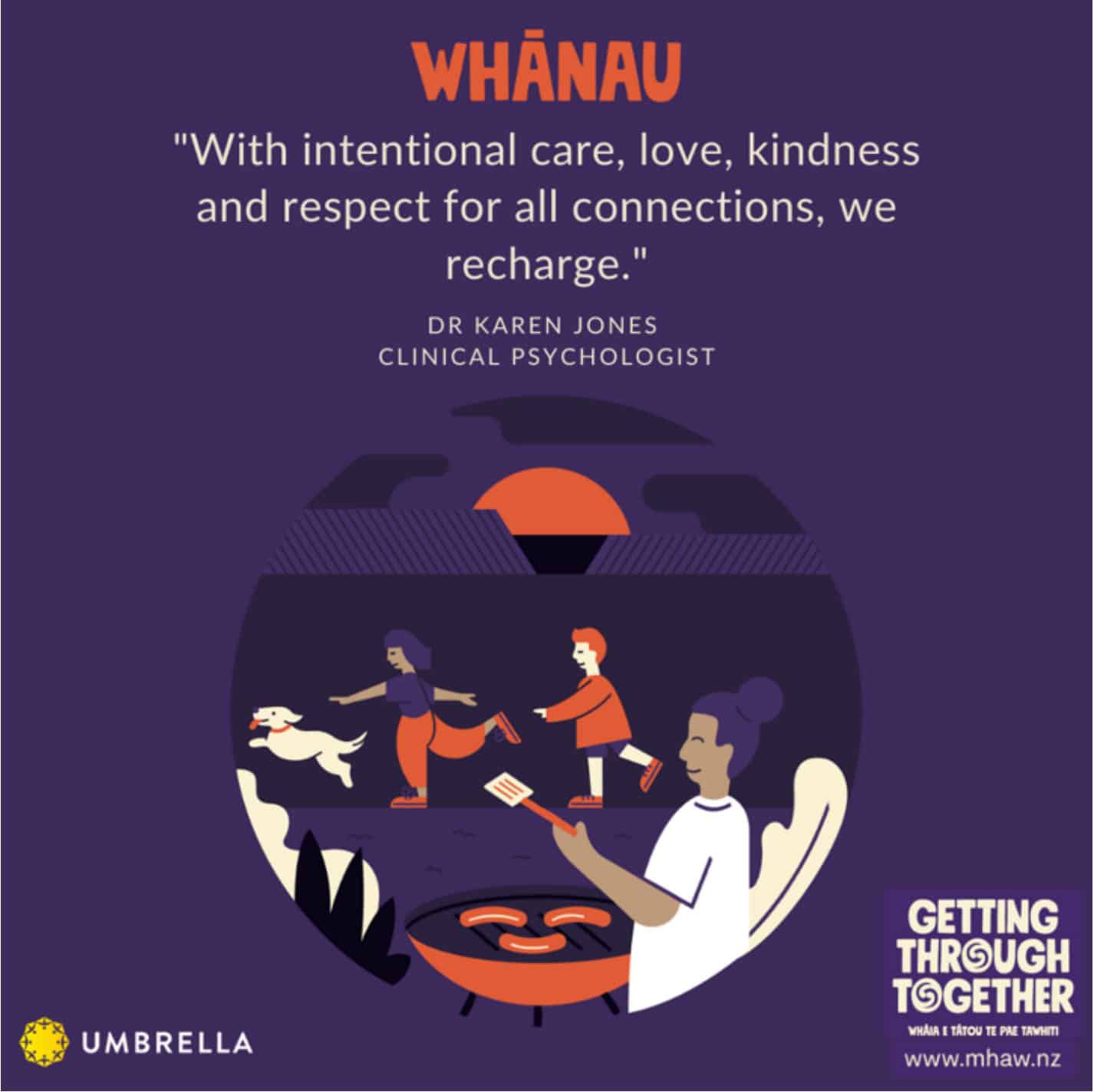
1. Whānau
Recharge with others – Whiria te muka tangata
Dr Karen Jones
Recharge each other
My whānau are those who have nurtured, cared for and loved me throughout my life. While often not close in location, with lives that do not touch every day, I know they are always there. We are connected. Without condition, without judgment. They know me best and love me anyway. We recharge each other.
My whānau are those in my life who I have met and connected with in a special way. I am not someone who has a wide collection of friends but those who I am lucky enough to call friends are people I trust, respect and love. Like my family, we may not be close in proximity, but we are close in connection. We recharge each other.
My whānau are also those who I may not know well but are integral to my life. My neighbours, those I pass regularly on my walk, in the supermarket, on the street, those who support me and others in my local library, dairy, and medical centre. We recharge each other.
My whānau is my kin, my friends, my community, my city, my country, my planet. Those people and places I know and those I may never meet or visit. With intentional care, love, kindness and respect for all connections, we recharge. And we can recharge each other.
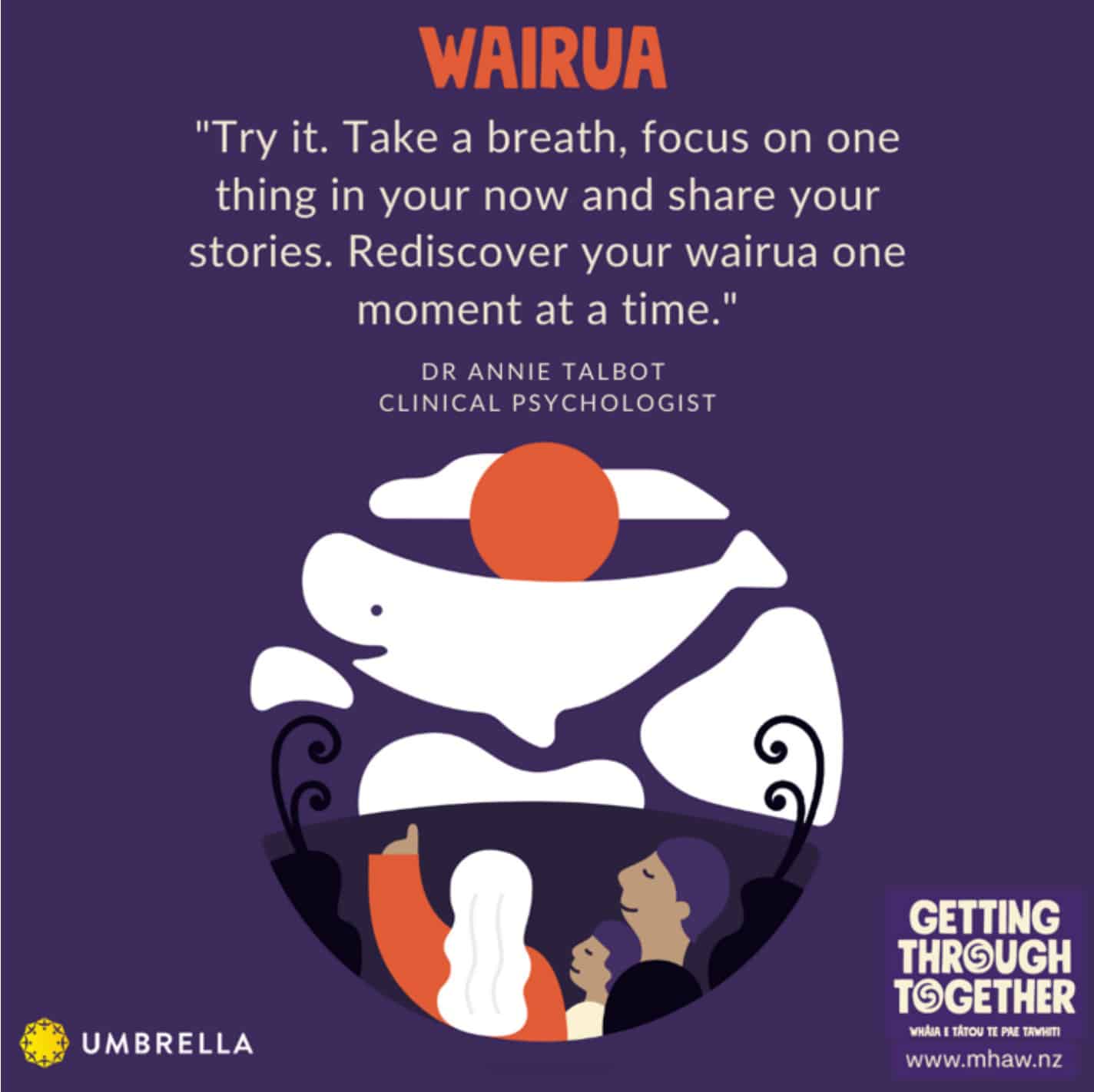
2. Wairua
Rediscover everyday wonder – Whāia ngā mīharotanga o ia rā
Dr Annie Talbot
Finding time to be present with your now
The saying, “It’s not the amount of breaths you take but the moments that take your breath away” is so true.
Yesterday, I was struggling with a million different tasks and I thought I was doing a bad job at all of them. Mum, wife, psychologist, business owner… Then, my 5-year-old daughter asked me to sit down and draw with her. She needed someone to help her sharpen pencils. So, I started doing this with my mind half on this task and half in my head.
Then she reached over to me, touched my face, kissed my cheek and said, “Great job, mama”. It stopped me in my tracks, took my breath away, I looked at this beautiful, kind, curious person and felt so grateful to be there, right then. I then refocused on sharpening my pencils but this time with all of my attention. I forgot how deeply satisfying it is to sharpen a pencil. Sitting in the sunlight, next to my girl quietly sharpening pencils together turned into the highlight of my day, recharging my soul in that moment. It took a 5-year-old to teach me to rediscover my wonder at the simple things. Try it. Take a breath, focus on one thing in your now and share your stories. Rediscover your wairua, one moment at a time.
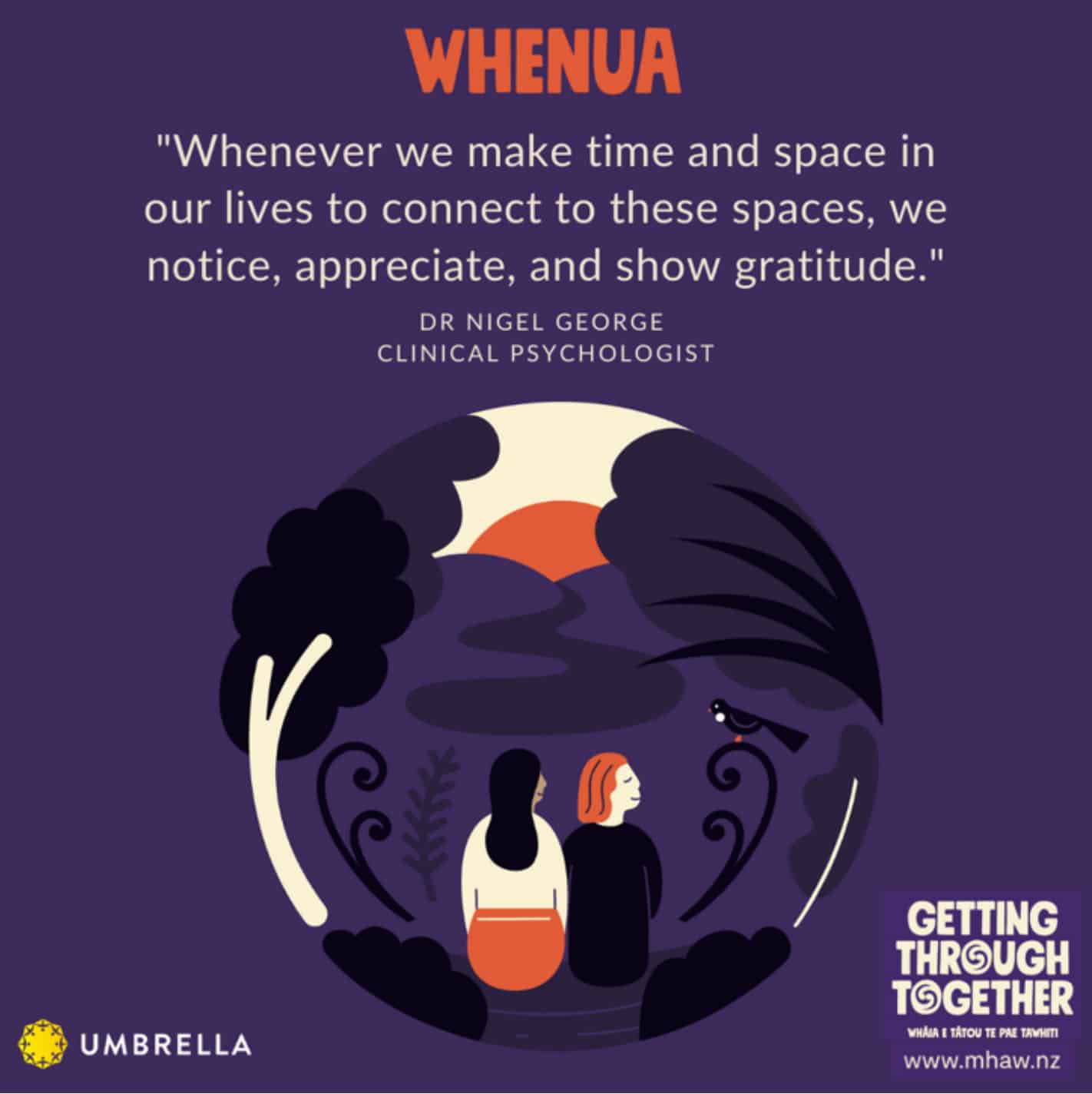
3. Whenua
Return to nature – Hono ki te taiao
Dr Nigel George
Connections in many forms
People from all over the globe have recognised for millennia the importance and interconnectedness of people, culture, nature, the land, and wellbeing. It is not until relatively recently, however, that science has started to catch up with this “traditional knowledge” and examined the positive relationships between these foundations. The interconnectedness of all these elements to our wellness – physical and mental – forms a fundamental bond that helps to enhance our wellness.
This connection can take many forms. For tangata whenua, connecting to the land and one another through tūpuna/ancestors can bring a sense of belonging and comfort, while for Japanese people the idea of mindful forest bathing – shinrin-yoku – might bring one closer to nature and peace. Whenever we make time and space in our lives to connect to, and through, these spaces, we notice, appreciate, and show gratitude. Neurologist Oliver Sacks captures the beauty of this gratitude for whenua when he commented what an “enormous privilege” it is to be “a sentient being, a thinking animal, on this beautiful planet”.
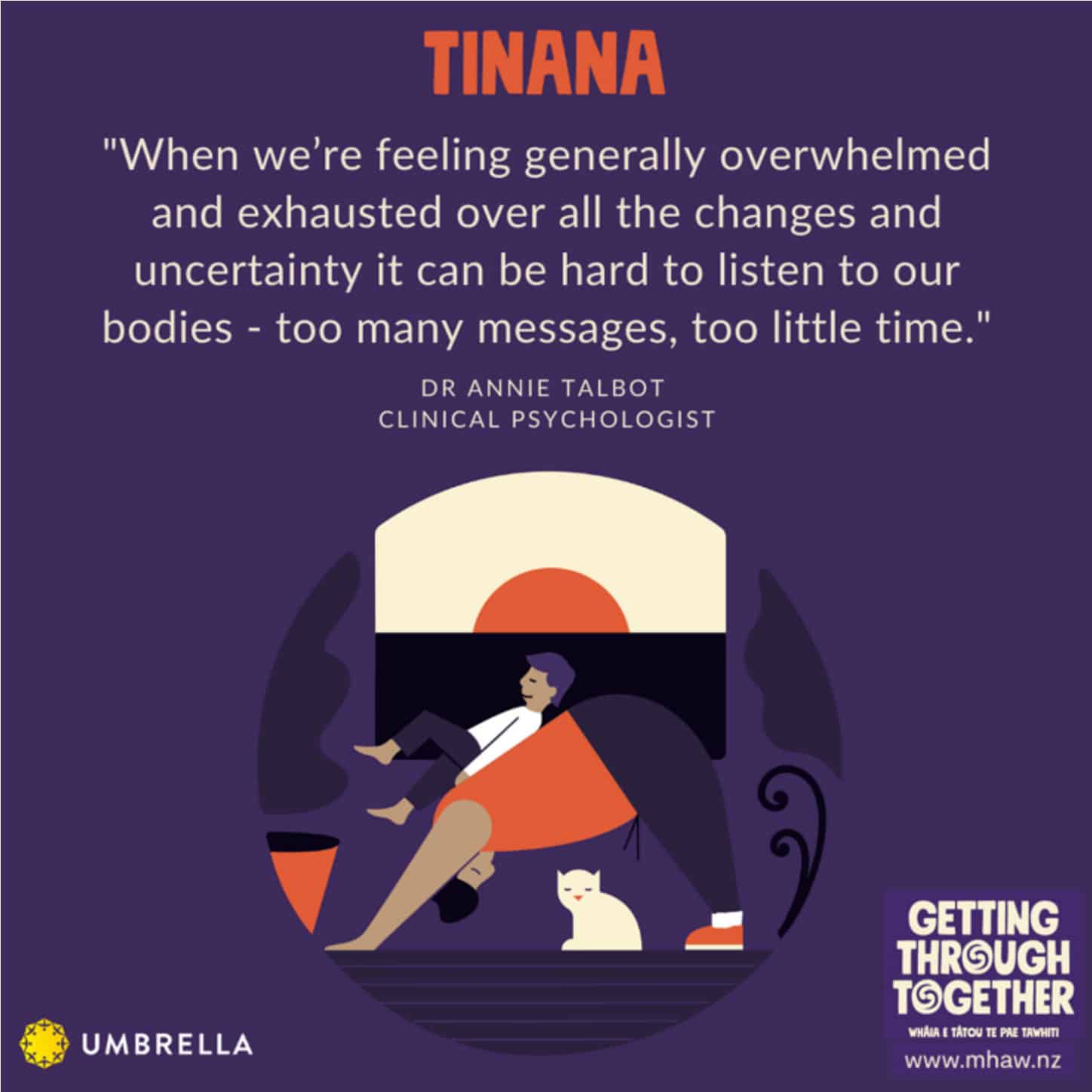
4. Tinana
Refuel your body – Whakamarohi i tō tinana
Dr Annie Talbot
Listening to your body
When we’re feeling generally overwhelmed, and exhausted over all the changes and uncertainty, it can be hard to listen to our bodies – it can feel like there are too many messages, too little time. Sometimes we need to TIPP ourselves back into our bodies and out of those pesky thoughts that can make us feel stuck.
So, my advice is to try TIPP:
T- Temperature change – quickly change your temperature (cold cloth, warm bath, really cold drink, use a bowl of ice, cold shower if you are brave enough).
I – Intense exercise – just 30 seconds of high-intensity exercise, getting your heart rate up.
P – Pair with paced breathing – pair either the temperature change or the exercise with slowed, paced breathing. Breathe in through your nose for a count of 4, hold for 4, then let it go through your mouth, breathing out for 4.
P – Perspective – check in by asking, “What does my body need right now?”
For me, this means, every morning I start with a warm shower but at the end I have a 30-second blast of cold shower, tipping myself out of my mind and back into my body with the cold water. I sing/I shout but I suddenly feel more present in my body. I then pair it with slowed, paced breathing, then I scan my body and just notice how it feels and ask it what it needs in that moment. Or when I feel overwhelmed or stressed, I find one minute to run up and down the back steps at my office or do sit-ups, then pair that with paced breathing, and again check in with my body, scanning it to see what it needs in that moment. It doesn’t change the world, but it can help you rediscover the wonder of your body and what it can do for you. Try it and see if you notice your body more. Sometimes, to find what we need in the moment, we just need a wee TIPP in the right direction.
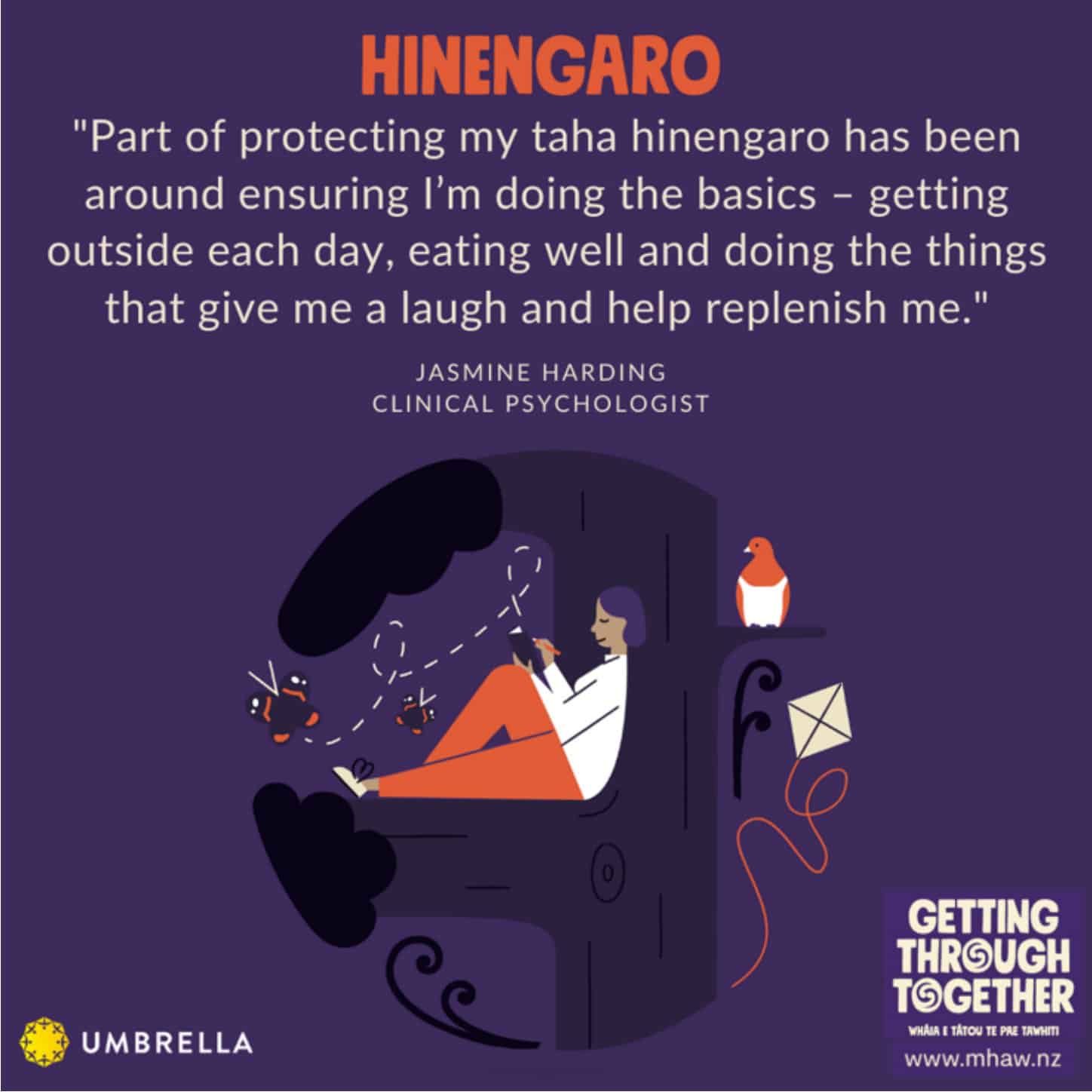
5. Hinengaro
Refresh your mind – Whāngaia tō hinengaro
Jasmine Harding
Thinking about the basics
When I think of taha hinengaro, I think about how I think and feel about myself and the things around me. It’s something that is changeable and sometimes fragile. I know it needs to be prioritised to keep me well. When my taha hinengaro is strong, that’s me saying yes to offers to connect with family and friends, as well as me initiating those catch-ups. It’s me feeling energised by my work, being boundaried with it, as well as having other activities outside of work to focus my energy on. It’s me being disciplined to say no to some things on the weekend and therefore allowing me to have “me time”. As for this year, it’s me acknowledging that 2020 has been an emotional rollercoaster and, with that, there have been moments of worry and concern. Part of protecting my taha hinengaro has been around ensuring I’m doing the basics – getting outside each day, eating well and doing the things that give me a laugh and help to replenish me.
If you liked these reflections and you’re interested in more insights from our team, join the wellbeing conversation on our LinkedIn and make sure you’re signed up to our team newsletter here.


